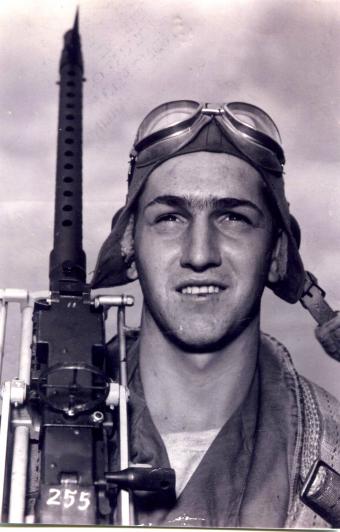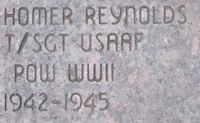Military Veterans

Homer L. Reynolds
Date of Birth
Date of Death
Brick Location
Panel Number

Biography
World War II Veteran Homer Reynolds
Salutes Parents, Brothers, Country
at El Dorado’s Celebration of Freedom Memorial Site
In 1943—as Elmer and Gladys Reynolds watched the last three of their six sons leave El Dorado to fight in World War II—they must have had mixed feelings: pride (no doubt), faith (probably), fear (yes), and an overwhelming hope for their safe return.
They could not then foresee in those dark days that each of their boys—all who served in combat roles and one who was a Prisoner Of War in Germany—would return safely. They could not then predict the war’s outcome, nor could they fully understand the ultimate purpose for victory overseas that involved their sons’ willing response to our nation’s call.
And undoubtedly, they would have been surprised that 63 years later, their fifth son, Homer, would choose to pay tribute to them by purchasing a bench at the Butler County Celebration of Freedom Memorial on El Dorado’s Court House lawn.
Speaking on behalf of his brothers (Navy Veteran Richard and younger brother George—who was not old enough to fight in World War II), Homer Reynolds attributes their parents’ love as well as a sense of obligation and service taught in the home that gave the boys the courage to “go when they were called and do the best they could.”
“Living through the depression got me through prison camp. The deprivation of those years prepared me for what happened there. We lived in Little River, KS until I was in eighth grade (when we moved to El Dorado) and I remember the depression very well. My father gardened four lots and fed practically the whole town of Little River. He always knew where we boys were because we were tending the garden.”
After graduating from El Dorado High School Homer went to work modifying B-25’s for North American Aircraft Company in Kansas City. “I wanted to learn to fly, knew I would probably soon be drafted, so volunteered for the Army Air Force,” he says. “This was before the formation of the Air Force as we know it today,”
After basic (bombadier/navigator) training in Waco, TX, he went to Gunnery School at Arlington, KS, followed by Mechanic School at Biloxi,MS. From there he observed construction of a B-24 Liberator airplane from start to finish at Willow Run, MI, and then was sent to Kerns, UT, where he was assigned to the 460th Bombing Group, 15th Air Force—also known as the Black Panthers.
He was shipped overseas from Savannah, GA, and after a few months in Tunisia, was sent to Spinizzola, Italy (near Anzio) where the 460th was headquartered for the remainder of the war.
In April, 1944, on a mission to bomb a German airplane factory in the industrial part of Vienna when Homer was shot down and parachuted out, landing on the Czechoslavakian/Hungary border. He was taken to Budapest where he was interned with nine other members of his crew for 120 days; from there they were force marched to Sagon, Germany, and then split into two groups: half sent on foot to Nuremberg and the other half, to Moosburg, Germany.
Homer’s memories of his rescue from the POW camp include receiving word (the night before) from his POW commander, Colonel Alcar that, according to their German guards, General Patton had the camp surrounded.
“The Americans would be moving in the next day, and Patton had given the Germans a chance to surrender. Many of them did; some did not. Sure enough, the next day, the tanks came roaring in, with Patton sitting on top of the first tank—‘bearing arms’— his pearl-handled pistols.”
Homer met a driver on one of the tanks and learned he was from Topeka, KS. The soldier gave him a “V-mail” (a popular way to correspond with loved ones during World War II) on which he wrote home to his folks to let them know he was all right.
(Interestingly, while he was a prisoner, Homer had been permitted to send four post cards and two letters a week back home to his family, none of which they received until after the war). His family, however, had learned he was a POW through the Red Cross in Switzerland.
The ex-POWs were sent to Landshut, Germany; then to France (Ike’s headquarters); then to Normandy where he, with hundreds of other Americans troops, were lined up to board liberty ships destined for home.
“It was a 19-day voyage to Boston. We landed at Camp Miles Standish, where we were processed and issued new clothes. Another kid (from Severy, KS) and I took a troop train across the country to Leavenworth, KS. From Leavenworth, I took a train to Wichita, and a cab from there to El Dorado. It was my birthday, June 9, 1945.”
Another element of interest in Homer’s story is that he served in the same squadron as El Doradoan Cliff Stone.
“Before I was sent overseas, I was taking The El Dorado Times and saw that Cliff (another El doradoan) was in Savannah and was with the 460th also. His design for the black panther, our squadron’s patch, had been selected to represent our squadron. So I looked him up and we met. He was taken prisoner of war the November after I had been captured in April.”
Homer still owns and is proud to wear the Black Panther jacket that bears the patch designed by Stone.
Homer’s awards from the war include the Air Medal with Two Oak Leaf Clusters, European Combat Medal, Meritorious Service Medal American Defense Medal, Purple Heart, Ex-POW, and Good Conduct Medal.
Other memories of the war: “When we first arrived at Spinizzola, Italy, there was nothing there. Only Army tents. It was January, wet and cold, snowy, knee-deep mud. We ate, slept, and worked in tents. Trench latrines. A menu of C-rations until the mess hall was built; then we ate a lot of sheep and vegetables which were plentiful around there. Lots of standing in line.
“For entertainment (between missions) we participated in sports—like football and baseball—to keep in good physical shape. We were entertained by a couple of USO groups. The fighter, Joe Lewis, came with one. The movie star Betty Grable came with the other.”
Homer’s favorite song of World War II was “Sentimental Journey.”
In addition to a memorial bench for their parents, the sons and their contributions to the preservation of freedom will also be observed in one of the memorial’s granite panels:
Navy Yeoman Second Class Frank Reynolds, who served in the Pacific, 1943-1946.
Army Staff Sergeant Claude Reynolds, who served in Europe, 1939-1946.
Navy Seaman First Class Alfred Reynolds, who served in the Pacific, 1943-1946.
Army Staff Sergeant Earl Reynolds, who served in Europe, 1942-1946.
Army Air Force Tech Sergeant Homer Reynolds, who served in Europe, 1942-1945, and who was a prisoner of war for 14 months.
Navy Petty Officer First Class Richard “Don” Reynolds, who served in Europe and in Korea, 1943-1952.
When asked how the war affected him in the years since, Homer reflected: “Life has been a lot better for me. It taught me the importance of sticking with a job. The importance of adjusting to the unexpected. I’m proud that I served.”
For those who fight for it, life has a flavor the protected will never know.
Branch:
Awards and Medals
- European-African-Middle Eastern Campaign Medal
- American Defense Medal
- Good Conduct Medal
- POW Medal
- Air Medal
- Meritorious Service Medal
- Purple Heart
Rank
Tech Sergeant
Years
World War II, European Theater of Operations, 1942-1945
Duty
60th Bombing Group, 15th Air Force.
Prisoner of War - 14 months in Germany.

